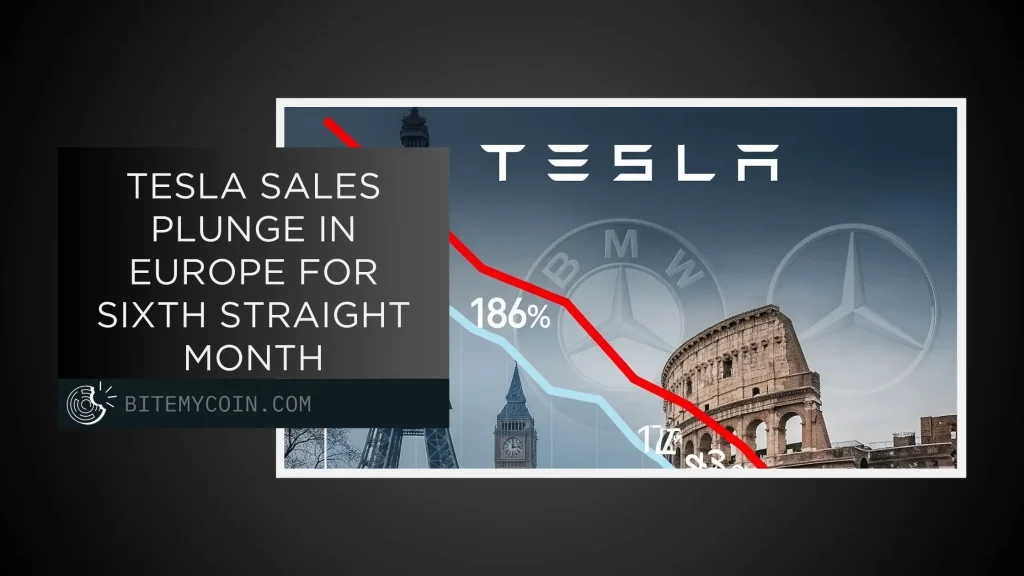EV manufacturer Tesla (NASDAQ: TSLA) continued its slump in the European market for the fifth consecutive month and six months running in Sweden and Denmark. The Texas-based company’s negative performance can be underscored by the competition it faces from rivals that are clawing its market share and CEO Elon Musk’s political affiliation.
According to data by the European Manufacturers Association (ACEA), Tesla registrations, a measure of sales in Europe, for May were 13,963 units, representing a 27.9% drop compared to a year earlier. Meanwhile, the total EV registrations in the region, including the United Kingdom, rose by 25%, but overall car registrations were down 0.6%.
However, Tesla performed better in May than in April, when sales dropped by a whopping 49% year-over-year. The company’s prospects were helped by the launch of the updated Model Y, but total sales in Europe between May 2024 and May 2025 are down 37.1% to 75,916 units.
Tesla Sales Decline for Sixth Consecutive Month in Denmark and Sweden, Data Suggests Slump Could Extend to Seventh Month
In Sweden and Denmark, Tesla sales fell by 64.4% and 61.6% year-over-year, respectively. The revised Model Y also couldn’t stop the downfall, as sales for the most affordable model in the automaker’s lineup fell 31.2% compared to 2024 to 1,155 cars.
Automobile research firm Schmidt Automotive reported that Tesla has suffered six straight year-on-year losses in quarterly new registration (sales) volumes across Western Europe, specifically in Nordic countries, with figures from June expected to make it seven consecutive months of negative sales.
In an email sent to Reuters, Matthias Schmidt, an analyst at the firm, wrote that when automakers release a new model update, it is an “extension strategy” for a product’s lifecycle, giving the company a short-term bounce. He noted that while the European market demand for BEV (battery electric vehicle) was growing, Tesla’s market share continued to shrink significantly.
Andy Leyland, co-founder of supply chain expert SC Insights, said that in smaller European markets, Tesla sold in hundreds or low thousands, which could have been the impact of logistics, stock levels, and delayed car launches. He added that only consumers could point out the reason for the drop in sales, which could be due to one of two reasons: Elon Musk’s support for US President Donald Trump or product-related issues.
Tesla’s latest European monthly car registration figures also coincided with a renewal in the high-profile fallout between Musk and Trump over the “Big Beautiful Bill”, which brings in sweeping tax cuts but with increased spending that could increase the US deficit by $5 trillion, resulting in the national debt surpassing well beyond $40 billion by 2030.
Musk, who worked closely with the Trump administration as part of the Department of Government Efficiency (D.O.G.E.) to identify wasteful government spending, has been strongly against increasing the federal budget.
Analysts are suggesting that Musk’s backpedaling on Trump may be a strategic move to dampen the damage it cost Tesla, but it comes too late.
Also Read: Hwang Dong-hyuk Says Squid Game 3 VIPs Resemble Elon Musk
Tesla Sales Across Europe are Down Significantly, With Only Norway Posting Positive Numbers
France’s PFA national auto lobby report showed that new Tesla registrations in the country dropped 67% in May to 721 units, with overall sales down 47% year-to-date. Mobility Sweden reported a 53.7% YTD decline in new registrations in May to 503 units. Meanwhile, sales dropped by 30.5% in Denmark, 36% in the Netherlands, 19% in Spain, and a massive 68% in Portugal. Norway was the only EU member state where Tesla sales increased during May.
The automaker does not report sales by region or monthly, making its upcoming Q2 2025 production and delivery report significant. The $1 trillion company, headquartered in Austin, Texas, is expected to announce its second-quarter results on July 22.
The EV giant’s TSLA stock has plunged 21.3% on a YTD basis. It has significantly underperformed its counterparts in the S&P 500 Index (SPX), which made a 5.5% gain during that time. The Consumer Discretionary Select Sector SPDR Fund (XLY) also outperformed Tesla despite dipping by 3.1% in the same period.
However, TSLA prices jumped 5.4% in the first trading session following the release of its Q1 earnings report in April, giving investors a glimmer of hope this time around.
Musk faced severe backlash from customers in the US and Europe for joining the Trump administration as a special advisor to the President. This massively affected Tesla’s revenues, which declined 19.6% year-over-year to $14 billion.
Investors are Looking Forward to Tesla’s Q2 Earnings Report
But electric vehicles aren’t the only area of business for Tesla. The company also designs, develops, manufactures, leases, and sells energy generation and storage systems. While car sales were down, its energy storage and generation, and services revenues made notable gains, partly offsetting the EV losses. But Tesla’s overall sales for Q1 dropped 9.2% YoY to $19.3 billion, and its net income to shareholders plunged 70.6% during the first three months of 2025 to $409 million
Investors remain optimistic on the stock after Musk announced production timelines for Tesla’s upcoming Cybercab robotaxis. Analysts are also remaining cautious about the stock’s prospects, with TSLA maintaining an overall “Hold” rating for the time being. Out of the 41 analysts who covered the stock, 14 graded “Strong Buys”, two graded “Moderate Buys”, 15 went with “Hold”, and 10 gave a “Strong Sell” rating.
At the time of writing, Tesla (TSLA) is trading at $317.66, down 1.84% in the last 24 hours.

